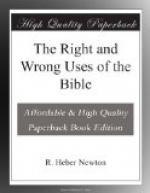Israel really needed the conserving work of a great organization. The prophetic religion was far in advance of the popular level. The high thoughts and lofty ideas of the prophets needed to be wrought into a cultus, which, while not breaking abruptly with the popular religion, should imbue the conventional forms with deeper ethical and spiritual meanings; should, through them, systematically train the people in ethical habits and spiritual conceptions; and should thus gradually educate men out of these forms themselves.
In the providence of God, and under the influences of His patient Spirit, this needful system was developed in the exile: a system whose symbolism was so charged with ethical and spiritual senses that it led on to Christ; as the Epistle to the Hebrews rightly shows and as Paul distinctly declares. As the first priestly period, following the first prophetic epoch, bodied that double movement in a book—Deuteronomy; so the second priestly period, following the second prophetic epoch, bodied this double movement in a book, or group of books—the present form of the Pentateuch. The traditions and histories and legislations of the past were worked over into a connected series of writings, through which was woven the new priestly system, in a historical form. On the restoration to Judea, this institutional reorganization was set up as the law of the land, and continued thenceforward in force—the providential instrumentality for the ad interim work of four centuries. Such a remarkable process of development, so deepening in us a sense of the guiding hand of God, ought to show some sign of its working, in the literature of the period. However clear, from our general knowledge, the tendencies which were at work in that period, we could not feel assured of our correct interpretation of this most important epoch, in the absence of some such sign, in a writing of that date.




